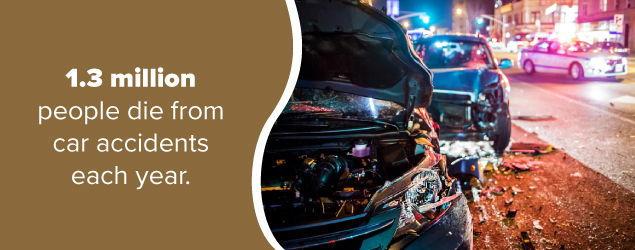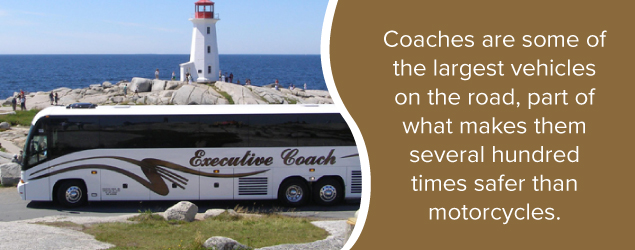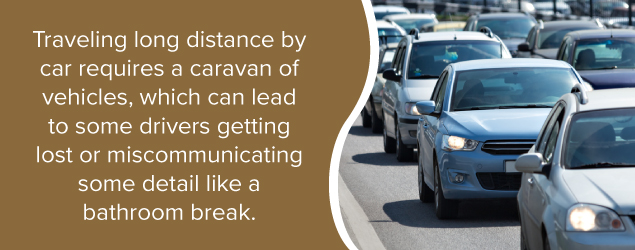
Today’s world involves a lot of travel. Not only does our country span more than 2,600 miles from coast to coast, but our infrastructure is such that we need to take some form of transportation if we’re going to go much of anywhere.
Choosing a method of transportation can be tricky. There are trains, airplanes and automobiles waiting to shuttle us between cities, but we have to do our research to figure out the best choice. The first consideration for most of us is cost, which we then invariably weigh against the time it takes to travel. Then come issues of comfort, convenience, environmental impact and hassle — not to mention safety.
All these factors and transportation mode options can quickly lead to a case of option paralysis. But as it turns out, there are plenty of reasons to travel in coach buses, and they excel in each of the aforementioned areas of concern.
The cost of bus and coach travel is low, and they move quickly while allowing you to read, work or nap as you go. The seats are comfortable, and the fuel efficiency is far better than cars or airplanes when divided over the number of passengers. There is no hassle and no need to show up early for a security screening. Best of all, bus stations tend to be located right in the city center — not an hour outside the city like many airports.
But are motor coaches safe? Though we sometimes ignore this question in light of mouth-wateringly low fares, it is the most important question to ask ourselves.
The answer is that coaches are one of the safest ways to get from Point A to Point B. In fact, coaches are second only to air travel in terms of safety, and even this ranking comes with a very slim margin. This may come as a surprise, as we are trained to view the highway as a pretty risky place — so to make sense of it, we’ll highlight how a road trip on a motor coach could be the safest mode of transportation for your next excursion.
Table of Contents
1. Motorcoach Drivers are Certified and Well-Trained
Just about everyone is allowed to drive a car, which is shocking when you consider the immense risk associated with the act of driving. Some of us are better drivers than others, and we have all experienced that feeling of helplessness and anxiety when we get in the car with someone whose driving makes us nervous. Add to that the staggering fact that 1.3 million people die from car accidents each year, or a tragic 3,287 deaths per day.

Coach bus drivers are reliably attentive and experienced. Keep in mind, every hour spent on the road is an hour of professional work, and drivers are under contract to keep their passengers safe and comfortable. Driving a bus is different from driving a car in many ways. For one, it requires a constant practice of scanning the coach’s surroundings. Coach drivers are consequently conditioned to always check and recheck their mirrors, resulting in a heightened awareness of what is around them. Buses are also longer and wider than most vehicles, so drivers practice extra caution when driving.
However, with coaches, there is no compelling reason to worry about the driver at all. The requirements necessary to become a professional coach driver are stringent — not only is a commercial driver’s license required, but the operator must also meet quality standards imposed by the company and undergo strict testing to determine their ability. This is one of the main factors in explaining how coach buses are the safest way to travel.
This specialized education means bus drivers are some of the best on the road. Think about it — when you receive your basic automobile license, you have to take a written test and a road test, depending on what state you live in. On top of this, bus drivers must complete the work that grants them certification for a commercial license. They then meet company guidelines. That is twice as much work, so there is no doubt they are adequately trained.
Another guarantee with professional drivers is smoothness. If a person is driving a coach, they did not get there by succumbing to road rage or by jerking the wheel around. Driving a bus also requires more care, which means hazardous driving is not even an option. Keeping passengers comfortable is both a skill and a priority, and often coaches will feel as smooth as an airplane at cruising altitude — minus the turbulence.
When conditions do get demanding, such as in construction zones, bad weather or rough roads, coach drivers have both the training and hands-on experience to guide passengers safely through. Remember, they have prepared for this extensively and your safety is their priority. If you follow the applicable charter bus travel tips, you and the driver can stay safe.
2. There are Numerous Coach Bus Safety Features, and the Buses Themselves are Designed to Withstand Accidents Without Serious Injuries
Why are coach buses a safe way to travel? The answer lies in their careful and considered design. Whereas a car’s safety comes primarily from its ability to crumple and deploy airbags in the event of an accident, a coach’s safety features are an integral part of its design.
The first and most important safety feature of any coach is its size. Teddy Roosevelt famously created the “big-stick” concept of diplomacy, in which he framed his concept of foreign policy as “speak softly and carry a big stick,” and a coach adheres to the same principle. Simply put, it is a gentle giant — its size commands respect and caution from others.
The sides of buses are reinforced with structural supports to withstand side and rear collisions. Passengers can rest assured the walls of the bus would stay rigid in the event of an accident.
Coaches are some of the largest vehicles on the road, which endows them with certain advantages. They are extremely visible — part of what makes them several hundred times safer than motorcycles — and their hefty size and weight mean they would naturally fare better in most collisions.

Next is the steel chassis on which buses are built. This structure runs from front to back, locking the entire vehicle together as one rigid object and giving it more ability to absorb shock. The weight of the chassis and engine also give the bus a relatively low center of gravity, which aids it in turning and maintaining stability.
The sides of buses are reinforced with structural supports to withstand side and rear collisions. Passengers can rest assured the walls of the bus would stay rigid in the event of an accident.
The seats of coach buses are one of their primary safety features. When any type of Newtonian force acts on passengers in a bus — that is, suddenly slowing down, speeding up or changing direction rapidly — the seat is the item that communicates the change to our bodies. Coach seats are well-cushioned and are designed to take many types of impact without serious injuries.
That said, every vehicle has an area that’s safer to sit in than the others, so there are a few factors to consider. You may be asking yourself, “What is the safest seat on a bus?” In general, you should avoid the front of the bus in case of a head-on collision. Conversely, many people who sit up front feel safer because they are closer to the driver, who has the natural instinct to protect. You also may want to avoid the back of the bus. Rear-end accidents happen, but they are not very common.
If you choose to sit on the side of the bus that faces oncoming traffic, be warned that these areas of the bus are susceptible to accidents, as well. It’s better to sit in the middle of the bus in the seat that’s closest to the aisle. You shouldn’t let that scare you, though. Buses are generally safer than most vehicles. But, if you have the option to choose your seat on the bus, try to sit toward the middle or back. These areas will receive the least amount of impact in case of an accident.
Coach buses do not usually have side-facing seats like public transportation buses do. This makes them even safer, as those seats offer no front or side protection. The front-facing seats in a coach bus protect from all angles. Because buses are so large, the other vehicle in a collision will end up taking most of the damage.
Should there be inclement weather, and your bus spins out on an icy road, the safest place to be is in the middle. In this instance, the front and back of the vehicle would take the most damage if the bus happened to hit any other cars or structures. If you are riding on a bus during the winter, try to position yourself in a middle row. Sitting toward the aisle can also allow you to get up more quickly in the event of an emergency. Accessibility is key.
Furthermore, windows on coach buses are typically glazed to avoid shards and dangerous edges in the event of breakage. Furthermore, some of the windows serve as emergency exits. Much like on a plane, there are more ways to get out than through the front door. This is extremely useful in case of an emergency. If you do end up sitting by the window on a bus, rest assured that you won’t be injured by any pieces of broken glass, even if there is an accident.
Finally, passengers in a coach are sitting fairly high above the ground. This position provides more than just a nice view of the passing countryside. In the event of an accident, the point of collision is well underneath the passengers, thereby protecting them from impact. So, even in the case of a collision or sideswipe, the bus will take the brunt of the damage.
Overall, coach buses are extremely safe. As time goes on, they tend to adopt more features that help them remain so. While all vehicles are built with passenger protection in mind, buses are some of the most formidable transportation systems on the market. No matter where you sit, a bus is still one of the safest ways to travel.
3. A Professional Inspects and Maintains Coach Buses After Every Trip to Ensure No Damage
Have you ever sat down on an airplane and asked yourself, “How has this thing been flying every day for 20 years?” The thought can be a bit unnerving, but the answer is constant and diligent maintenance. If we could be as attentive to our cars as mechanics are with buses and airplanes, there would be a lot fewer car problems in the world.
Companies that offer coach services need their fleet to last them a long time. The open highway and city streets can both offer plenty of problems for vehicles — there are potholes, clouds of dust, gravel rocks, road salt and general wear and tear that occur when we’re on the go. To keep the damage under wraps, mechanics will service coaches at the end of each trip and make sure all parts and safety features are working correctly.
The mechanics who service coaches after each trip are part of a full-time, professional staff who are uniquely acquainted with the workings of their buses. Details do not slip through the cracks — and the coaches also get a thorough wash to make sure they are sparkling clean for their next journey.
4. Motorcoaches Keep the Traveling Party Safely Together
One reason coach buses are so often the safest transportation method of choice for long-distance group travel is that they keep all members of the traveling party together. This minimizes the risk of someone disappearing from the group and causing a worrisome delay — and it is also where buses excel over every other form of transportation.
Traveling long distance by car requires a caravan of vehicles, which can lead to some drivers getting lost or miscommunicating some detail like a bathroom break. It can also lend itself to a somewhat chaotic scene when it is time to reconvene and different parties are searching for their passengers. In a bus, it is always easy to keep track of who is missing.

Train travel, in addition to being more expensive, often requires changeovers that can present challenges to groups who need to find different platforms during a stop. The train also leaves on a strict schedule, so if one member of the party is missing, there is no option to stall the departure to wait for them.
Plane travel suffers from the same problem. With the tediousness of ticketing, baggage and security, there are lots of opportunities for groups to become separated. Layovers in crowded airports can be hectic and often result in parties missing flights, which can set them back significantly if they are on a schedule.
With a bus, waiting for that one straggler may be frustrating, but at least it’s not impossible. It is also easy to designate a meeting time and point, and to keep all the group’s belongings in one place.
5. If Anyone Needs Medical Attention, a Bus can Divert to the Nearest Hospital
Picture yourself sitting on a plane, cruising through the atmosphere six miles above the ground. If someone needs medical attention, you are quite literally stuck until the plane can request clearance to make an emergency landing, safely descend and get transportation ready to transport the sick patient to the hospital.
This is one advantage of a bus trains or planes can never hope to match — in the event of a medical emergency, the bus driver can simply reroute and provide direct transit to the hospital.
6. The Statistics Speak Clearly About Coach Bus Safety
At the end of the day, we need to rely on data when making decisions on something as paramount as safety. So, what is the safest way to travel? When it comes to motorcoaches, the data makes it clear: Coaches are one of the safest ways to travel.
Automobile fatalities per year in the United States tend to hover between 30,000 and 40,000. Fatalities on motorcoach accidents typically average around 44, which makes motorcoaches responsible for between only 0.11 percent and 0.14 percent of all motor vehicle fatalities.

One of the most recent sample years, 2015, saw a total of 35,092 highway fatalities and 49 deaths for motorcoach passengers. That is just over one-tenth of 1 percent of the total deaths. Cars and motorcycles made up more than half these motor vehicle fatalities, with the rest being trucks and pedestrians.
However encouraging these figures may be, there is still the question of relativity. If buses make up such a small percentage of total travel deaths, could it be because they are less common than other vehicles? In other words, are the low fatality figures simply due to fewer people riding coaches in the first place?
To answer this question, we need to look at the number of deaths per miles traveled — especially how coach buses compare to planes and trains. As it turns out, bus and coach travel still comes out far ahead of the competition. In terms of deaths per 1 billion passenger miles, the rankings are as follows:
- Airplanes at 0.07 deaths per billion miles
- Buses at 0.11 deaths per billion miles
- Transit rail at 0.24 deaths per billion miles
- Rail at 0.43 deaths per billion miles
- Ferries at 3.17 deaths per billion miles
- Cars at 7.28 deaths per billion miles
- Motorcycles at 212.57 deaths per billion miles
The statistics above fairly conclusively demonstrate buses are on par with air travel in terms of safety. Plus, you don’t even have to worry about the fear of flying if someone in your group is afraid of air travel. The high safety ratings of buses should convince even skeptics: Coaches are often the best means of travel. And with the increasing usage of safety cameras, front collision warning devices and enhanced automatic braking, coaches are only going to continue becoming safer as we move into the next decade.
Traveling by Bus is One of the Safest Ways to Travel
When traveling, safety is ultimately the most important consideration. Buses dominate the safety ratings for terrestrial transport and nearly tie with airplane travel, which most people consider the safest mode of transportation available to us.
Drivers are well-trained and experienced, buses include loads of high-tech tour bus safety features, they are inspected after each trip, they keep your party together, they are never far from any hospital and they are statistically superior to every other land-based form of transportation in terms of safety.
If you have the option, try to sit toward the middle or back of the bus in a seat that’s close to the aisle. Though buses are entirely capable of keeping us out of harm’s way, this is a good rule of thumb. If you have to sit in the front, don’t worry – the driver’s natural instinct to steer our of danger will protect you. Many people actually prefer to sit in this area because of their trust in the driver. In any case, try not to worry, as charter buses are one of the safest ways to travel.
If you are considering moving a group of people from one place to another, whether for a school trip, church trip, wedding, or another reason, choosing a coach is the best way to minimize risk while also eliminating hassle. There are no lines, no security to deal with, no arriving two hours early, no layovers and no missed flights or trains. Your driver will be professional, courteous, knowledgeable and prepared for the journey.
To inquire about booking a coach for your next journey, contact Executive Coach to get a prompt reply and a quote. Let us show you why we are one of the best and safest companies in the entire industry — it starts with caring for the customer.





